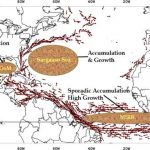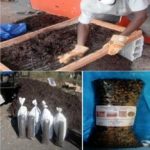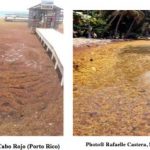Brown invasive algae in the Caribbean: Origin, concern and opportunities
 By Jodany Fortune, Clifford Louime and Gary Gervais
By Jodany Fortune, Clifford Louime and Gary Gervais
University of Puerto Rico – College of Natural Sciences – San Juan, PR
Contact: jodany.fortune@upr.edu
Since 2011, most Caribbean countries have complained of the invasion of algae called Sargasso in the beaches. The massive arrival of Sargasso to the shores has an impact on tourism, environment and health. Algae usually found are two species: Sargassum fluitans and Sargassum natans. They are pelagic algae, that is to say they have no need to cling to the bottom to reproduce. These species belong to the class of Phaeophyceae, the order of Fucales, Family of Sargassaceae and Genus of Sargassum. Morphologically, they consist of thallus (leaves), stem (stalk) and pneumatocytes (floats).
The abundance of xanthophylls and carotenes in these algae hides chlorophylls and give to them their brown color (yellow-brown) characteristic. Their color can pass from brown-yellow to dark-brown when dried on the beaches.
Mostly, these algae are found in large quantities in Sargasso Sea (Sargasso from the Italian word sargazzo means seaweed). Sargasso Sea is a part of the Atlantic Ocean located between the meridians 70º and 40º W and 25º parallel 35º N. It is the only sea in the world that has no coastline. Its boundaries are shaped by the North Atlantic Drift to the north, the Gulf Stream to the west, the Canary Current to the east, and the north-equatorial current to the south. Its total area – although variable – is 3.5 million square kilometers. This region is characterized by long absence of winds and currents on the one hand, and by the abundance of plankton on the other hand. In the past, sailing navigators feared this area due to lack of wind.
The waters slowly operate in this area a circular movement and all floating objects are gathered between its boundaries (Trash vortex). It is also the location chosen by the eels for spawning all the year.
What are the causes of the massive arrival of Sargasso in the Caribbean region?
Several hypotheses have been put forward to explain this phenomenon.
The first hypothesis mentions the absence of cyclones in the area (Sargasso Sea) for the past 10 years. This creates optimal conditions for the growth of these algae.
The second hypothesis refers to the deviation of the Gulf Stream to the south because of climate change. This change favors the arrival of massive algae in the Caribbean.
The third hypothesis mentions the intensifying arrival of Saharan dust rich in nutrients (Fe, K and phosphates) that promote algae growth.
The fourth hypothesis makes reference to the nutrient input from the rivers of the Amazon basin in Brazil and those from the Congo Basin (Africa) due to deforestation.
A fifth hypothesis also mentions the spill oil caused by BP accident (2010) in the Gulf of Mexico (206 million gallons of oil) as one of the possible causes of algae proliferation arguing that some nutrients have become more concentrated in the area after the oil is decomposed by bacteria.
The scientific community is not unanimously supporting all these hypotheses.
But, the most plausible hypothesis is that related to change in the ‘North Equatorial recirculation region’ (NERR) and the input of nutrients from the rivers of the Amazon basin. The ‘North Equatorial recirculation region’ between Brazil and Africa is strengthened due to the increase in the width of the Intertropical Convergence Zone (ITCZ) in recent years. This change, in fact, promotes accumulation and growth of pelagic Sargassum in this nutrient-rich area. New studies, using satellite imagery, have showed the presence of a small ‘Sargasso Sea’ ‘in the east of Brazil with an algae trail arriving until the West Indies.
Algal invasion in the beaches has an impact on tourism, health and the environment. How can we turn this problem to opportunity?
In fact, these algae as other biomass type can be converted into biogas (energy source), in organic fertilizer for soil amendment or as an alternative to feed animals. They can be process also into charcoal briquettes (an alternative energy source to charcoal).
Effects on tourism activity
The paradisiacal beaches with turquoise water in the Caribbean waiting for tourists (From Barbados to the Dominican Republic via Ile-à-vache to Mexico) have been invaded by tons of algae. The offensive odor caused by the decomposition of these algae scared away tourists. Many visitors have canceled their stay in these affected countries.
In Mexico (Cancun), the cost of beach cleaning invaded by algae rises to 15,000 pesos (1 peso = 0.060 dollar Mexican US) or $896.63 for each meter of the coastline. Mexican authorities have planned to spend about $9.1 million and hiring 4,600 temporary workers to clean the algae that have submerged the Caribbean coast of Mexico. Faced with this situation, the island of Tobago has declared a “state of natural disaster”.
It is clear that the invasion of algae on the beaches has a cost on tourism revenue of some countries in the region.
Health impact
Algae are neither venomous nor allergens. However, it is not recommended to swim in the sea with high concentrations of algae in order avoid risk of drowning. The presence of rafts of algae in the sea that provides shelters for some marine species can cause itching in contact with skin. Under certain conditions, decomposition of algae on the beaches releases hydrogen sulfide (H2S) that causes smell of ‘’rotten eggs’’. Hydrogen sulfide is a toxic gas, but the level of toxicity is a function of the inhaled doses and the duration of exposure.
The olfactory pathway perceives H2S to a concentration of 0.05 ppm; this can serve as a warning signal. When it reaches a threshold of 2 ppm, we must prevent access to the public beaches. But when the concentration reaches the threshold of 50 to 200 ppm, it paralyzes the olfactory nerve and at 300 ppm we lose consciousness.
H2S can provoke, even at low doses, irritation of eyes and respiratory tract.
Consequently, people suffering respiratory illnesses (respiratory insufficiency asthma, chronic bronchitis, etc.) should avoid areas of beaches where seaweeds are decomposed.
Even through the collection of fresh algae is harmless, professionals fitted with appropriated masks are required to manage algae deposits releasing ‘rotten egg’ odor to avoid exposition from H2S emanations.
Environmental impact
The presence of algae in the water is very useful for certain species. Algae serve as food and shelter to some marine species (lionfish, young sea turtles, tuna, kingfish, Sargassum fish camouflaged, juvenile pufferfish…). Under certain conditions, the presence of algae in the beaches helps to fight against sea erosion. But, at high concentrations, they affect the marine flora and fauna located near the coast. The accumulation of algae in the water prevents light passing through the surface. The fixed or immobile organisms are most affected. For example, seagrasses and corals are affected by the lack of light for photosynthesis. On the beaches, algae disturb the nesting of sea turtles and thereby make difficult, if not impossible, the arrival of baby turtles on the shore.
In addition, the decomposition of algae leads to water alteration, which subsequently leads to the death of certain fish species susceptible to a low oxygen concentration.
Managing and valorization of Sargasso
A control plan must be developed to deal with the invasion of algae that generates pollution and threatens the economies of the region:
The best option would be the collection of algae in the open ocean with suitable vessels to prevent the possible arrival on the coasts. Otherwise the release of millions will be like pouring water into a bottomless bucket (barrel of Danaides)! If no, for each new arrival, we will have to start the collection on beaches.
For a better management of the invasion of algae, we can:
– Improve knowledge of the massive arrival of algae by combining satellite imagery and wind models (study of currents).
– Support the efforts of communities for algae collection.
– Implement structures with large capacity of collection and valorization of algae.
The collected algae can be valued in different ways: Bioethanol, medicines, plastics, flocculants, alginate, biogas, bio-char or coal briquettes, organic fertilizers, animal feed (goats). In this article, we will put emphasis on the valorization of Sargasso into biogas, coal briquettes, organic fertilizer and animal feed.
Biogas production
Sargassum spp. like any other type of biomass is a source of energy after transformation in anaerobic conditions. These algae can be transformed into biogas (consisting primarily of methane and carbon dioxide), which is an energy source. At laboratory scale (University of Puerto Rico, Rio Piedras), we are testing this feasibility. These studies are making on two 15L bioreactors at different salinities (10 ppt, fresh water) and 35 ppt (seawater). In this experiment, for every gram of volatile solids (VS) of algae used, we have a production of 69.3 ml and 50.25 ml respectively of biogas in the 10ppt and 35ppt bioreactor.
As algae contain about 70% VS this means is possible to produce under these conditions an average of 48.4L and 35.09 L for each Kg of total solids (TS) respectively in the 10ppt and 35 ppt bioreactor. The percentage of methane in the biogas produced is 54% and that of CO2 is 32.5% for the 10 ppt bioreactor. In the bioreactor using seawater, the percentage of methane (CH4) is 57.5% and that of CO2 is 26%. The calorific value of the biogas produced by the 35 ppt bioreactor is 20600 KJ / m3.
Biogas production yield in the 10 ppt is higher than 35 ppt due to the presence of two inhibitors of methanogenic in seawater (sodium and sulfur). The most important here is to note that it is possible to produce biogas from Sargassum spp. as biomass by using seawater. However, the operation of a bioreactor in seawater requires a sacrifice about 1/3 of biogas production obtained under conditions of 10 ppt (control reactor). This cost may be acceptable if we consider the advantage of eliminating the need of fresh water in the bioreactor operation. If fresh algae is used the biogas production can be multiplied by 3. In fact, the drying process affects the biodegradability of algae in anaerobic digestion.
Note: Before using seawater to operationalize an anaerobic bioreactor, we need to consider the choice of materials quality due to salt corrosion and hydrogen sulphide in the biogas.
Briquettes of coal
These algae can also be used as a source of biomass for the production of coal briquettes. After pyrolysis, the carbon powders from algae can be mixed to proportions from 40% to 50% with other carbon powders (other biomass) to produce coal briquettes (an alternative to charcoal for some countries).
Organic fertilizers
Algae also have benefits in terms of agriculture for soil amendment by considering their nutrient composition (especially for potassium intake). For example, after transformation into biogas in an anaerobic system, the effluents are excellent sources of nutrients. Even with the low concentration of nitrogen (N) (6.3 mg / 100 g), phosphorus (P) (96.5 mg / 100 g) and potassium (K) (28 mg / 100 g), the ratio of NPK (1-10-3) of Sargassum spp. is recommended as organic fertilizer. The important thing is a high percentage of NPK does not necessarily mean better fertilizer. NPK ratios in organic fertilizers are generally smaller compared to conventional or inorganic fertilizers [3]. Organic fertilizers release nutrients slowly over time, especially when they are reinforced by soil pH located between 6.5 and 6.8 that increases the capacity of the soil fertility.
Some advantages of using Sargassum spp. as organic fertilizers:
• Improving water retention capacity of the soil,
• Promote the growth of beneficial soil microbes
• Strengthen the development and root growth
• Improve the absorption of nutrients through the roots
• Increase the fruit yield
• Encourage abiotic stress tolerance in plants
• Improving defense against pests and diseases (nematodes, fungal and bacterial pathogens)
Feed for animals (goats)
Experiments have shown that Sargassum spp. can be used as an alternative for feeding goats. Sargassum spp. contains 8% of crude protein and 39% of carbohydrate with fractions of fibers, minerals, vitamins and fatty acids.
NB: For the use of algae in agriculture practices, we need to remove the excess of salt. Otherwise, it may pose a problem of soil salinization and/or pollution of groundwater. The river mouths are recommended to remove the excess of salt in algae after collection. The exposure of algae to the rain after gathering beside the beach can help remove the excess of salt.
In summary, the invasion of algae (Sargassum spp.), a recent phenomenon, is certainly due to the impact of human activities on marine ecosystems in the Atlantic Ocean and the Caribbean Sea. There is currently no scientific consensus on the origin and the specific causes of this massive invasion of algae in the region. The changes occurring in recent years in the ‘North Equatorial recirculation region’ caused by climate change and the input of some nutrients from the rivers of the Amazon basin seems to be the plausible explanation to this phenomenon.
The accumulation of algae in the beaches has impacts on tourism, marine ecosystems balance in the region. It can also affect the health of people who attend beaches. But availability of this huge algal biomass offers some new opportunities mainly for sustainable energy and agricultural activities. In fact, these microalgae can be transformed into biogas, in coal briquettes (or coal pellets) and organic fertilizers for soil amendment. Now it is the moment to change this disadvantage into opportunities.
IMAGES:
sargassum_morphology.jpg Morphology of Sargassum fluitans and S. natans: (Doyle and Franks, 2015; Le Lann, 2009)
sargassum_arrival.jpg Source: ifremer.fr/guyane/content/download/41806/569470/file/Sargasses%20Guyane.pdf
sargassum_growth.jpg The regions of accumulation and algae growth in the Atlantic Ocean (Franks et al 2014. Johnson et al. 2013)
sargassum_beaches.jpg
sargassum_fertiliser.jpg









